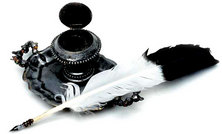Monday, July 9, 2007 |
— Fiction —
Great Moments in Inkdom
Everyone should marvel at great works of literature, especially those composed in ink. Here are the more notable examples of writers who overcame great obstacles to see their ink in print.
 Hamlet
Hamlet
William Shakespeare left Stratford with nothing more than a coal stone in his pocket and a dream—to be the most famous playwright who wrote with coal. But his dream was short lived. Shakespeare was allergic to coal and his words disappeared each time he sneezed. Feeling pity for his hypoallergenic colleague, fellow dramatist Christopher Marlowe loaned the young playwright a quill and an inkwell. Shakespeare’s creative output increased dramatically and he pays homage to the ceremonious liquid in the opening lines of Hamlet: “To quill and to quill, that is the answer.”
The Declaration of Independence
Contrary to popular belief, the only interaction Marie Antoinette and Benjamin Franklin had during his decade-long French sabbatical was a biweekly sex romp orchestrated by King Louis XVI. Nonetheless, the decadent queen did introduce the bespectacled inventor to ink. When he presented the liquid to the Continental Congress, the delegates immediately took a liking—primarily because they’d been composing with dry quills and hence, couldn’t read what they’d written. Strangely, no written account of this record exists. Nonetheless, when word reached the British crown, George III retaliated with the Ink Tax of 1776. Talks of rebellion were rampant on the mainland. Feeling outraged, the yet to be founders of the yet to be country that was yet to be free called upon Thomas Jefferson to author a Declaration of Ink Dependence—the k in ‘Ink’ later removed for copyrighted purposes.
Moby Dick
In the mid 1800s ink was reserved for the literary elite, most of whose last name ended in Hawthorne. After the success of his first two novels, Typee and Omoo, Herman Melville wrote Moby Dick in ink. But Melville, an ink novice, made one fatal error. He used blue ink rather than the more conventional black. As a result, critics panned Moby Dick for being “too blue,” and not until the Blue Ink Revival of 1919, which coincidentally fell on the same year as Melville’s centennial, was Moby Dick recognized for its blue-inked mastery.
The Adventures of Huckleberry Finn
Being too poor to afford clothing and too eccentric to wear it, the nudist Mark Twain was repeatedly haggled while rafting down the Mississippi River. After one quarrel with the locals, he was tarred and feathered with ink and clothing, this being a common practice of the slave-owning south. Now a bundled mess of tweed and coagulated cow hoof, Twain had an epiphany. He stripped his clothes and began his most important work of fiction, Huckleberry Finn—originally conceived as a nude man’s quest to write the great American novel with only the ink on his skin.
Ulysses
James Joyce had to overcome glaucoma and personal tragedy to compose Ulysses, but most notably his revulsion of ink (he was Catholic). Dubliners and The Portrait of an Artist as a Young Man were composed in pencil, as Joyce was fond of erasers (again, he was Catholic). With a pencil he could write a sentence, erase, edit, then rewrite any number of times until his words maintained a logical coherence. However, during the first page of the ambitious novel, Joyce’s pencil broke and he didn’t own a sharpener (had nothing to do with his Catholicism). Out of shear desperation, and an inability to recognize the blasphemous writing utensil, Joyce wrote pages and pages of unedited prose with a fountain pen he found beneath the leg of his chair. The end result was the largely indecipherable, yet critically lauded, Ulysses.





